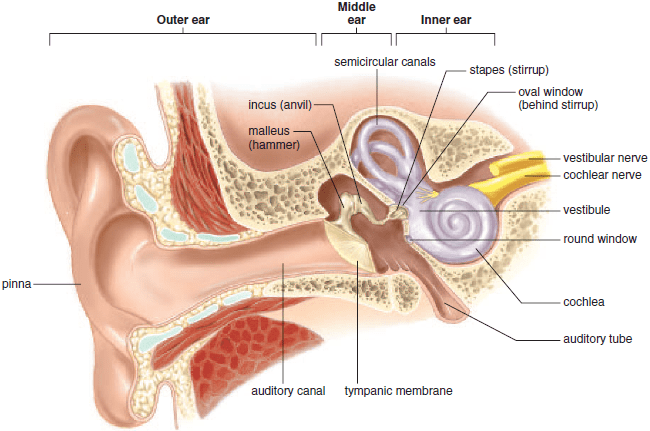Hearing and Hearing Loss
Procedures
How the ear works
The outer ear (pinna) funnels sound into the ear canal towards the eardrum. Sound waves cause the eardrum (tympanic membrane) to vibrate, which in turn vibrates the bones (ossicles) in the middle ear. Vibrations from the ossicles stimulate hair cells in the hearing organ (cochlea) within the inner ear. These vibrations are transformed into electrical signals that travel up the auditory nerve to the brain.

Hearing loss
Hearing is crucial for learning, communicating, and safety.
Hearing loss is a loss of loudness or clarity of sounds and can happen suddenly or gradually. (If you have had a sudden hearing loss, see a doctor urgently).
When hearing loss is gradual, many people do not realise that they are losing their hearing. Relatives, friends, and colleagues are often the first to notice. They may get the impression that you are not listening to them, or you have the TV up too loud. Conversations can be slower and more difficult than earlier, particularly in noisy environments.
It is natural to try and compensate by reducing distance or watching the speaker. However, this is not always possible and can get quite tiring or stressful. You may miss the starts and ends of words and have to guess the rest, or often have to ask for people to repeat themselves. This can be frustrating and can cause misunderstanding, embarrassment, and isolation.
There are two main types of hearing loss:
- Conductive hearing loss
This is due to problems affecting the transmission of sounds through the outer and middle ears. Examples include temporary conditions, such as excessive wax build-up, or fluid behind the eardrum, or medical conditions, such as otosclerosis (abnormal bone growth in the middle ear), or perforated eardrums - Sensorineural hearing loss
This is due to disorders in the inner ear, hearing nerve, or associated brain structures. The hair cells in the cochlea are extremely sensitive and deteriorate over time. Damage can also be due to excessive noise exposure, ear disease or degenerative conditions.
Your child’s hearing
If you are concerned your child has a hearing loss, finding it early is good for their language, learning and social development.
All babies born since April 2010 in Auckland would have been offered a screening test within their first few months of life.
https://www.nsu.govt.nz/pregnancy-newborn-screening/universal-newborn-hearing-screening-programme
The B4 School Check is the final Well Child check. It includes a hearing check by a Vision and Hearing Technician. If your child does not pass the hearing screen, they should have further testing by an audiologist.
Even if your child was screened, it does not exclude progressive hearing loss or temporary issues – i.e. fluid behind the eardrum, glue ear, perforated eardrums. If you have concerns about your child’s hearing, you should consult your GP about seeing an audiologist.
Tinnitus
Tinnitus is the perception of noises in the ears and/or head that are not related to an outside source. It is often described as a ringing in the ears but can be experienced differently for people (e.g. buzzing, whistling, hissing, roaring).
Tinnitus is a symptom that is usually related to an underlying problem such as hearing loss. However, people with good hearing can also experience it.
For many people, tinnitus is just a nuisance. For others, it can affect their sleep, concentration, work and everyday life.
Tinnitus can be aggravated by certain factors, including hearing loss, exposure to loud noise, stress, caffeine, nicotine, alcohol, and certain medication.
There is no “cure” for tinnitus, and treatment is aimed to reduce its annoyance and managing your response to it.

